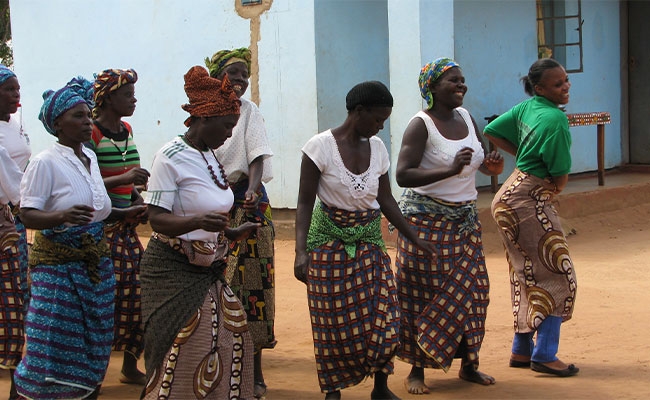Strengthening Wildlife Resource Governance in Zambia
Empowering women through participation quotas and leadership support to improve gender inclusion in Zambia’s Wildlife and Fisheries sector
Published 08-19-20
Submitted by Tetra Tech

This piece was written by Tetra Tech’s International Development Land Right’s team in collaboration with U.S. Agency for International Development’s (USAID) Jennifer Duncan, Patricia Malasha, and Matt Sommerville.
This post originally ran on LandLinks.
Zambia is home to some of Africa’s most spectacular landscapes, premier national parks, and Africa’s Big Five game animals—lions, leopards, rhinoceroses, elephants, and African buffalo. Each year, nearly 1 million visitors make wildlife tourism a major contributor to Zambia’s economy and one of the few sources of formal employment for communities in rural areas. Yet, one of Zambia’s most important demographics is often conspicuously absent from management decisions and benefits from the wildlife sector—women. For decades, USAID has been working with partners to protect Zambia’s threatened wildlife and enhance rural livelihoods. Recently, USAID’s Integrated Land and Resource Governance Program assessed the gender dimensions of community-based wildlife interventions in Zambia, particularly focusing on experiences in Zambia’s Eastern and Muchinga Provinces.
Meeting Women in the Chifunda Fishing Camp
On the third morning of our trip to Muchinga Province, we came upon a group of locals deep in the bush, fishing on the Luangwa River in a game management area. The party of mostly women and girls had set up a crude camp site on the riverbank, where tree branches could not protect them from the rain. They had pots of small dried fish, which they caught by wading out into the river with thatched fish traps. This setup posed various occupational hazards, including hippos and crocodiles in the water and hyenas and elephants walking through their camp in the darkness of night. They told us they come for several days at a time and once they fill their bags with fish to sell at the market, they trek 15 kilometers (9.3 miles) back to their village. Some of the women are from families that own small tracts of land for farming and come in the off-season; others have no land to farm at all. For all women in this sector, the income from fishing ends up being vital to their families’ welfare.
Earlier that morning we had seen men fishing from small boats in a wider section of the river, where they can safely catch much bigger fish using efficient metal fish traps. Cultural norms do not permit the women to go out on the water in boats and fish. Their place, they are told, is on the shore.
The women in the Chifunda fish camp are among the many in Zambia whose lives intersect at multiple points with wildlife resources. The survival of their families depends on these fisheries, and they are partly responsible for the stewardship of this critical resource. In the bush, they face the threats of human-animal wildlife conflict and hike long distances carrying fishing baskets and pots. Their knowledge of these resources is both unique and valuable. Since they are left out of wildlife management, the perspective of women and mothers is largely absent from conservation dialogues.
It is highly probable that none of the Chifunda women will ever have a role in decision-making or employment related to Zambia’s wildlife and fisheries sector on the Community Resource Board (CRB). Due to pervasive gender norms and practices that keep women out of these roles, women are left, yet again, watching and working from the shore. Zambia has partially decentralized management of its wildlife sector to CRBs, as well as to fisheries and forest management groups. CRBs operate across vast chiefdoms where government and customary institutional responsibilities overlap. But, there are no guidelines on the role of women in these groups, only strong customary gender norms that sideline women in resource management and benefits. In fact, CRBs are purposefully working to serve men’s interests, and there is a striking lack of transparency and accountability in resource use. Women’s representation in some CRBs and Community Forest Management Groups is very low, and completely absent in others. The Chifunda CRB has no women on its 10-member board, and neighboring Chikwa CRB has 3 women members. Of the 76 CRBs in Zambia, 72 are led by men, and the few women who participate experience challenges in the male-dominated structures.
Hiring Practices and Biases Create Barriers to Women Working in Wildlife
Women do not have the same employment opportunities as men in the wildlife sector. The inequitable training criteria for scout selection exclude even well-qualified women candidates. New hires are usually arranged through informal channels, based on social connections, and not through standard and transparent procedures. Education qualifications—like a grade 12 education—English fluency, and competitive physical trials, such as timed runs with packs, end up excluding many women. No policy exists to encourage either the state or the CRBs to employ women in the wildlife sector.
In fact, few women are ever employed—only three out of 38 game scouts working for Chikwa CRB are women. The Chifunda CRB, which patrols resources more than 200,000 hectares chiefdom, has hired only three women among its 57 scouts. When employed, women scouts are hurt disproportionately by common practices of non-payment (for up to a year). Women employed in poacher sting operations appear to face significant gender-based violence risks.
Tackling Gender Biases in the Wildlife Sector Will Require a Multi-Pronged Approach
Based on the assessment findings, USAID’s Integrated Land and Resource Governance Program continues to work with civil society partners on practical ways to improve women’s participation and empowerment within the natural resource management sector. In 2020, the program is supporting the training of the first cadre of female scouts and rolling out gender sensitive election guidelines and training for CRBs in partnership with the Department of National Parks and Wildlife and Zambia’s National CRB Association. These are just the first steps of many to give women proper representation in the decisions made over community resources. With a focus on women’s economic empowerment, USAID is working with community-based natural resources management organizations in Zambia to support women’s leadership within the wildlife sector through participation quotas and leadership support from community level to national policy with the Department of National Parks and Wildlife. Activities focus on creating opportunities for fair employment and constructive dialogue on gender norms within these rural communities. Experiences are being shared across Zambia’s wildlife and forestry sectors creating novel learning and scaling opportunities for women’s empowerment.
Effective wildlife management at the community level entails much more than chasing down poachers—something women are able to do just as well as men. It is largely about improving education and awareness of community members—both men and women—raising awareness about harmful and illegal practices, and encouraging involvement in alternative livelihoods. The USAID assessment makes clear that both women and men interact with wildlife, depend on it for subsistence and cash income, and bear responsibility for the sustainable use of wildlife resources. It is optimal that teams include women and men to reach every segment of society. Employing women is not only fair, it is smart.

Tetra Tech
Tetra Tech
Tetra Tech is a leading provider of high-end consulting and engineering services for projects worldwide. With 27,000 associates working together, Tetra Tech provides clear solutions to complex problems in water, environment, sustainable infrastructure, renewable energy, and international development. We are Leading with Science® to provide sustainable and resilient solutions for our clients. For more information about Tetra Tech, please visit tetratech.com or follow us on LinkedIn and Facebook.
More from Tetra Tech

